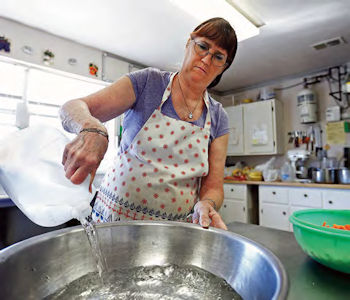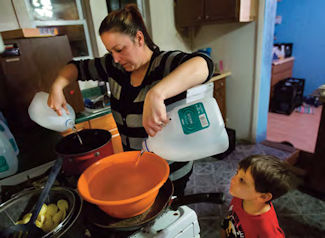SEJournal Online is the digital news magazine of the Society of Environmental Journalists. Learn more about SEJournal Online, including submission, subscription and advertising information.
Cover Feature
By LAURA UNGAR
 |
| Sandra Porter, the cook and water operator at Ozark Action Head Start in Ava, Mo., pours a gallon of bottled water into a bowl while she cooks for the school’s children. The Head Start has a well on its property, but the school doesn’t use it because samples from faucets have shown high lead levels. Photo: Guillermo Hernandez Martinez, USA TODAY NETWORK |
For environmental and health reporters across the country, the crisis in Flint, Mich., highlighted a long-festering and much larger problem with lead-tainted water, spurring us to ask: What about other places? What about my city?
The USA TODAY Network set about trying to answer those questions by examining U.S. Environmental Protection Agency data and then diving deeply into our findings through old-fashioned, shoe-leather reporting.
I helped lead the national coverage, along with reporters Alison Young and Mark Nichols, and we all received feeds, data and documents from our Gannett colleagues throughout the country. Many of them, in turn, wrote local stories based on the data, making this a truly network-wide effort.
Our investigation resulted in two major national stories. One focused on overall findings identifying almost 2,000 water systems in all 50 states where testing has shown excessive levels of lead contamination over the past four years. The other looked specifically at lead-tainted water at schools and day cares. Around 350 of these are served by water systems failing lead tests, but most are not required to test for lead at all because of a gaping federal loophole.
We all learned a lot from this experience — lessons that may be useful to other journalists taking on this complicated but crucial topic. Here are a half-a-dozen lessons for your own reporting on lead in drinking water.
Lesson No. 1: Check and re-check the data. Data is the backbone of any project like this, so it’s crucial that it be as reliable as it can be. Our data came from the EPA’s Safe Drinking Water Information System, or SDWIS. We summarized 2012-2015 data that documents instances where lead contamination in water samples reached an “actionable level” under federal regulations.
As with any large data set, human error at any point in the data collection process can cause inaccuracies. For instance, one water system serving a day care in Maine appeared to have the highest lead level of any school or day care in the data set. But it turned out that someone had entered the result incorrectly, putting 20 parts per million instead of 20 parts per billion. After the property owner balked at the numbers I shared with him, I checked with state officials, who pointed out the error.
Such “outlier” findings may appear stunning, but reporters need to make sure they are true.
Lesson No. 2: Go beyond the numbers. Real people give these stories heart. We had some very strong findings, but we needed to make readers care. And that meant focusing on what high lead levels meant to people’s lives.
One of my colleagues talked to a trailer home resident in Maine, mother of an 8-year-old daughter, who got a notice on her door last year alerting her to potential lead contamination in the neighborhood. The property manager blamed tap water from a single old trailer, and told a USA TODAY Network reporter to stop interviewing residents. The mom and her daughter still don’t know for sure if their water is tainted with lead, but nonetheless now drink bottled water.
For the story on schools and day cares, I spoke with an Ithaca, N.Y., mother whose son drank from water fountains at an elementary school where several spots tested high for lead. A blood test on the 7-year-old found more than twice the average level for lead in young children, even though as far as anyone knows, he’s never been exposed to lead paint or tainted soil.
These types of stories bring the issue home to readers, who can see themselves in those living with the danger of potential lead poisoning.
 |
| Melissa Hoffman, 40, expresses her concerns about the high lead levels found at her children’s school, Caroline Elementary School, during a town hall meeting March 3, 2016, in Ithaca, N.Y. Photo: Romain Blanquart, USA TODAY NETWORK |
Lesson No. 3: Give as much context as possible. We need to put numbers, and the overall problem, in context.
In the school story, for example, it was imperative that I tell readers that about 90 percent of schools, and the vast majority of day cares, are not required by the federal government to test for lead in water. That means the disturbing findings from the EPA data refer to this 10 percent minority of schools, and it’s impossible to know the true scope of the lead problem. Some of the unregulated schools test voluntarily, and many of them have found lead in their water — hinting at a very big and widespread problem indeed.
Our investigation also focused a lot on the issue of notifying the public, since people can’t take action unless they know they’ve got a problem. We found that when testing did reveal high lead levels, many people weren’t warned as required. And of 180 cited for failing to notify the public, almost half were cited more than once. Delays in notification sparked outrage among parents in Ithaca, who said they were robbed of the opportunity to protect their children.
Lesson No. 4: Keep the national picture in mind, but localize. The story of lead in water, as it has unfolded, is an interesting blend of local and national. The Flint crisis began as a local story but then inspired national examinations of the problem. And the national examinations turned up data that could be used locally.
That’s what we did within the USA TODAY Network, with many of our papers writing local stories from the national data. I am a dual employee for USA TODAY and The Courier-Journal in Louisville, and wrote a local story on schools and day cares in Louisville in addition to anchoring the national story on the topic.
Meanwhile, my C-J colleague, environmental reporter and SEJ member, Jim Bruggers, wrote a story about the network investigation’s findings that all water utilities in Kentucky and Southern Indiana comply with a federal rule on lead in drinking water, but that the EPA is calling on states to do more to ensure residents know which communities have lead problems and where the lead service lines are located. Other reporters from across the network also did stories looking at what the data said about their cities, towns and states.
Lesson No. 5: Interpret the science and policy in a readable way. As any environmental or health reporter knows, science and policy are key to stories like these. But both of those things can quickly get complicated and be difficult for the general public to understand. That’s when we become translators of a sort.
For instance, there’s no safe level of lead, which I described in the top of my school story as “a notorious toxin that can silently damage developing brains and slow growth in little bodies.” My colleagues Alison and Mark got into the various ways it can sicken people, saying it can “… damage growing brains and cause reduced IQs, attention disorders and other problem behaviors. ... Adults are not immune, with evidence linking lead exposure to kidney problems, high blood pressure and increased risks of cardiovascular deaths.”
Alison and Mark also explained the EPA’s “action level” (which is different from a “safe” level) in a very readable way: “The EPA determines that a system has exceeded the lead standard when more than 10 percent of samples taken show lead levels above 15 parts per billion. It’s called an ‘action level’ because at that level, water systems are required to take action to reduce contamination.”
 |
| Lee Anne Walters of Flint, Mich., pours gallons of bottled water into a bucket and pan to warm up for her twin sons to take a weekly bath. Her son, Gavin, 4, looking on, has been diagnosed with lead poisoning. “I was hysterical,” Walters said. “I cried when they gave me my first lead report because the thought was ‘Oh my God, my kids.’ I’m one of those moms that I watch what my kids eat. I make sure they get enough fruits and vegetables. All of my kids are avid water drinkers.” Photo: Ryan Garza, USA TODAY NETWORK |
Lesson No. 6: Be aware of the competition. With Flint so much in the news and the issue of lead in water so timely, we knew we didn’t have all that much time to complete our investigation and write our stories. We also heard other media outlets were crunching the same data that we were. This meant very tight deadlines. We worked long hours, especially toward the end, because we wanted to get the story right and also get it first. And there was a lot of coordination with other papers in the network as well. It all worked out, though, and running all of our content within a short period of time packed a big punch.
Since our stories and others have run, policymakers have been focusing more intensely on the issue of lead in water. Several bills have been proposed in Congress. New York lawmakers proposed a flood of bills in that state, according to the Rochester Democrat & Chronicle, some citing the USA TODAY Network investigation and articles by Gannett newspapers in New York. One proposal there would shift responsibility of testing for lead in water from schools and day cares to local water departments; another would start a new fund with at least $200 million for water infrastructure renovation.
I saw the Democrat & Chronicle story while I was away teaching a group of college journalism students. The timing was great, since it reinforced something I always tell budding journalists when I give such talks — that our profession gives us a chance to make a difference in the world, at least once in a while.
Laura Ungar is a Louisville, Ky.-based national/regional health enterprise reporter for USA Today, The Courier-Journal and Gannett. She’s been a reporter since 1990, previously working for The Hartford Courant in Connecticut, and The News Journal in Wilmington, Del. She has covered medical issues for a dozen years.
* From the quarterly news magazine SEJournal, Summer 2016. Each new issue of SEJournal is available to members and subscribers only; find subscription information here or learn how to join SEJ. Past issues are archived for the public here.












 Advertisement
Advertisement 



